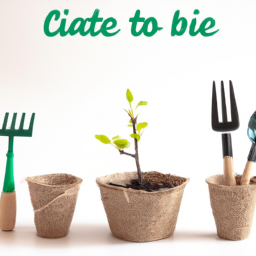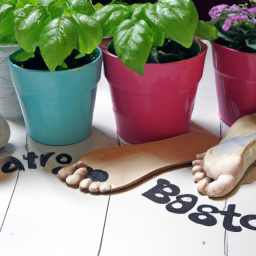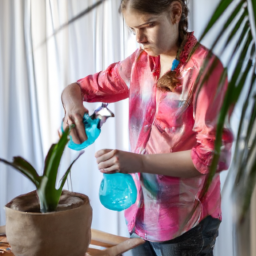
Are you looking to reduce your water usage while still maintaining a lush indoor garden? In this blog post, we will explore the world of Water-Wise Indoor Gardening: Conservation Techniques. With the increasing concern over water scarcity and the need to conserve this precious resource, it’s important to find ways to grow plants indoors without wasting water. Luckily, there are several techniques and tips that can help you achieve a beautiful and thriving indoor garden while being mindful of water usage. Let’s dive in and discover how you can become a water-wise indoor gardener.
Benefits of Water-Wise Indoor Gardening
Welcome to the world of water-wise indoor gardening! In this guide, we will explore the numerous benefits of adopting conservation techniques in your indoor garden. By following these practices, you can not only save water but also create a sustainable and thriving indoor oasis.
Reduced Water Usage
One of the primary benefits of water-wise indoor gardening is the significant reduction in water usage. By implementing conservation techniques such as using efficient watering systems, capturing rainwater, and choosing drought-tolerant plants, you can minimize water wastage and lower your water bills.
Additionally, by being mindful of your watering habits and only watering when necessary, you can prevent overwatering and water runoff, which can lead to water pollution and nutrient leaching. This not only conserves water but also helps protect the environment.
Overall, reducing water usage in your indoor garden not only benefits your wallet but also contributes to water conservation efforts and promotes sustainable living.
Healthy Plant Growth
Another key benefit of water-wise indoor gardening is the promotion of healthy plant growth. By providing your plants with the right amount of water at the right time, you can prevent water stress, root rot, and other water-related issues that can hinder plant growth.
Conservation techniques such as using well-draining soil, mulching, and proper watering schedules can help maintain optimal soil moisture levels and create a healthy growing environment for your plants. This, in turn, can result in stronger, more resilient plants that are better equipped to withstand environmental stressors.
By practicing water-wise indoor gardening, you can ensure that your plants receive the water they need to thrive while minimizing the risk of water-related problems that can compromise their health and growth.
Sustainable Living
Lastly, adopting conservation techniques in your indoor garden promotes sustainable living and environmental stewardship. By reducing water usage, minimizing water wastage, and choosing water-efficient practices, you can minimize your environmental footprint and contribute to conservation efforts.
Water-wise indoor gardening aligns with the principles of sustainability by promoting resource conservation, reducing pollution, and fostering a deeper connection to the natural world. By incorporating these practices into your indoor garden, you can play a part in creating a more sustainable and eco-friendly living space.
In conclusion, the benefits of water-wise indoor gardening are numerous and far-reaching. By implementing conservation techniques in your indoor garden, you can reduce water usage, promote healthy plant growth, and contribute to sustainable living practices. So why wait? Start implementing water-wise techniques in your indoor garden today and reap the rewards of a thriving and sustainable indoor oasis.
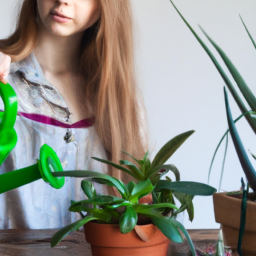
Water-Wise Indoor Gardening: Conservation Techniques
As an expert in water-wise indoor gardening, I am passionate about helping individuals conserve water while maintaining a thriving indoor garden. Water conservation is crucial, especially in today’s world where water scarcity is becoming a growing concern. By implementing the right techniques, you can reduce water consumption in your indoor garden without compromising the health and beauty of your plants.
Understanding the Importance of Water Conservation
Water is a precious resource that should not be wasted, especially in indoor gardening where water usage can add up quickly. By conserving water, you not only help the environment but also save money on your water bill. Additionally, water conservation promotes sustainable gardening practices, which are essential for the health of our planet.
When it comes to indoor gardening, it is important to remember that plants have specific water requirements. Overwatering can lead to root rot and other issues, while underwatering can cause plants to wilt and die. By understanding the water needs of your plants and implementing water-wise techniques, you can ensure that your indoor garden thrives while conserving water.
There are several techniques you can use to conserve water in your indoor garden. From choosing the right plants to implementing efficient watering methods, these strategies can help you reduce water usage without sacrificing the beauty of your indoor oasis.
Choosing Water-Wise Plants
One of the most effective ways to conserve water in indoor gardening is to choose water-wise plants. These are plants that are well-adapted to low-water conditions and require minimal watering. Succulents, cacti, and other drought-tolerant plants are excellent choices for water-wise indoor gardening. These plants store water in their leaves and stems, allowing them to survive with minimal watering.
In addition to choosing water-wise plants, you can also group plants with similar water needs together. This allows you to water them more efficiently, as you can tailor your watering schedule to meet the needs of each group. By grouping plants with similar water requirements, you can avoid overwatering or underwatering, which can lead to water waste and plant stress.
Another strategy for conserving water in indoor gardening is to use containers with good drainage. Well-draining containers prevent water from pooling at the bottom, which can lead to root rot and other issues. When choosing containers for your indoor garden, opt for pots with drainage holes and use a well-draining potting mix to promote healthy root growth.
Implementing Efficient Watering Techniques
Efficient watering techniques are essential for water-wise indoor gardening. One of the best ways to conserve water is to water plants deeply but infrequently. This encourages deep root growth and helps plants become more drought-tolerant. Instead of watering your plants lightly every day, water them deeply once or twice a week, depending on their water needs.
Another effective watering technique is to water plants in the morning. This allows the water to soak into the soil before the heat of the day evaporates it. Watering in the morning also helps prevent fungal diseases, as the leaves have time to dry before nightfall. By watering your plants in the morning, you can reduce water waste and promote the health of your indoor garden.
Lastly, consider using a drip irrigation system or a self-watering container to conserve water in your indoor garden. These systems deliver water directly to the roots of the plants, reducing evaporation and water waste. Drip irrigation systems are especially efficient for large indoor gardens, as they can be customized to meet the water needs of each plant.

Tips for Implementing Water-Wise Practices in Indoor Gardening
Understanding Water-Wise Gardening
When it comes to indoor gardening, water conservation is essential for maintaining a healthy and sustainable environment. Water-wise gardening involves using techniques and practices that help reduce water waste while ensuring that your plants receive the necessary hydration. By implementing water-wise practices, you can not only save water but also promote the growth and health of your indoor plants.
One of the key principles of water-wise gardening is efficient water use. This means watering your plants only when necessary and using techniques that minimize water evaporation and runoff. By understanding the water needs of your plants and the best watering practices, you can ensure that you are not overwatering or underwatering your indoor garden. Additionally, using water-efficient irrigation systems, such as drip irrigation or a watering can with a spout, can help you target the water directly to the plant roots, reducing water waste.
Another important aspect of water-wise gardening is soil health. Healthy soil can retain moisture better, reducing the need for frequent watering. To improve soil health, consider adding organic matter, such as compost or mulch, to your indoor garden. This will not only help retain moisture but also provide essential nutrients to your plants. Additionally, using a well-draining soil mix can prevent waterlogging, which can lead to root rot and other plant diseases.
Choosing Water-Wise Plants
When planning your indoor garden, consider choosing water-wise plants that are well-suited to your environment and require minimal watering. Succulents, cacti, and other drought-tolerant plants are excellent choices for water-wise gardening, as they can thrive with infrequent watering. These plants have adapted to survive in dry conditions by storing water in their leaves or stems, making them perfect for indoor environments with limited humidity.
In addition to choosing water-wise plants, consider grouping plants with similar water needs together. This will allow you to water them more efficiently and prevent overwatering or underwatering certain plants. By creating a watering schedule based on the needs of your plants, you can ensure that each plant receives the right amount of water without wasting any.
When watering your plants, be mindful of the time of day and the watering method you use. Watering your plants in the early morning or late evening can reduce water evaporation and ensure that the water reaches the plant roots. Additionally, using a watering can with a spout or a drip irrigation system can help you target the water directly to the plant roots, minimizing water waste.
Conserving Water in Your Indoor Garden
In addition to efficient watering practices, there are other ways to conserve water in your indoor garden. Consider collecting and reusing water from sources such as dehumidifiers, air conditioning units, or rainwater. This water can be used to water your plants, reducing the need for tap water and saving money on your water bill.
Another way to conserve water is to reduce water evaporation by using mulch or a humidity tray in your indoor garden. Mulch can help retain moisture in the soil and prevent water evaporation, while a humidity tray filled with water can increase the humidity around your plants, reducing the need for frequent watering. Additionally, using a saucer or tray under your plant pots can catch excess water and prevent it from evaporating or leaking onto your floors.
By implementing these water-wise practices in your indoor garden, you can not only save water but also promote the health and growth of your plants. By understanding the water needs of your plants, choosing water-wise plants, and conserving water through efficient watering practices, you can create a sustainable and thriving indoor garden that benefits both you and the environment.
Let’s wrap up what we learned
Indoor gardening is a popular way to bring a touch of nature into your home, but it’s important to be mindful of water usage to ensure that you’re being environmentally friendly. Water-wise indoor gardening is all about using conservation techniques to reduce water waste and promote the health of your plants. One key strategy is to choose drought-resistant plants that require less frequent watering, such as succulents, cacti, and snake plants. These plants have adapted to survive in arid conditions and can thrive with minimal water.
Another important technique for water-wise indoor gardening is to water your plants efficiently. Instead of giving them a little water every day, it’s better to water deeply but infrequently to encourage strong root growth. You can also collect and reuse water from sources like dehumidifiers or air conditioning units to give your plants a sustainable source of hydration. By implementing these conservation techniques, you can enjoy a lush indoor garden while also doing your part to conserve water and protect the environment.
Here are some FAQs you’d be interested in:
Q1. What is water-wise indoor gardening?
A1. Water-wise indoor gardening refers to using conservation techniques to minimize water usage while still maintaining healthy and thriving indoor plants. This includes using efficient watering methods, choosing drought-resistant plants, and maximizing water retention in the soil.
Q2. How can I conserve water in my indoor garden?
A2. To conserve water in your indoor garden, you can use techniques such as watering plants early in the morning or late in the evening to reduce evaporation, collecting and reusing water from household activities, using self-watering pots, and incorporating water-efficient irrigation systems.
Q3. What are some drought-resistant plants suitable for indoor gardening?
A3. Some drought-resistant plants that are suitable for indoor gardening include succulents, cacti, snake plants, ZZ plants, and spider plants. These plants require minimal watering and are well adapted to survive in low-water conditions.
Q4. How can I improve water retention in the soil of my indoor plants?
A4. To improve water retention in the soil of your indoor plants, you can add organic matter such as compost or peat moss to the soil, use mulch to cover the soil surface and reduce evaporation, and choose pots with good drainage to prevent waterlogging.
Q5. Are there any other tips for practicing water-wise indoor gardening?
A5. Yes, some additional tips for practicing water-wise indoor gardening include grouping plants with similar watering needs together, regularly checking for signs of overwatering or underwatering, adjusting watering frequency based on plant growth and environmental conditions, and investing in a moisture meter to accurately monitor soil moisture levels.
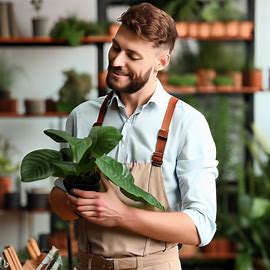
Alex Turner is a sustainable gardening advocate and the founder of an acclaimed indoor gardening blog. With a focus on eco-friendly practices and urban sustainability, Alex combines his background in environmental studies with his love for plants to educate readers on mindful indoor gardening. His work highlights the importance of nurturing both plants and the planet.

